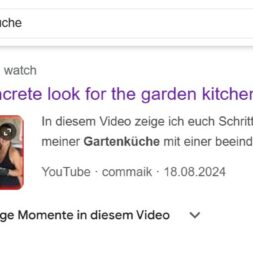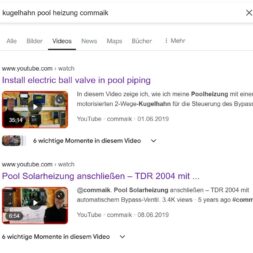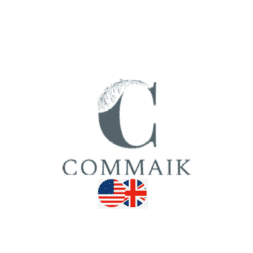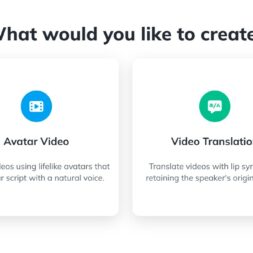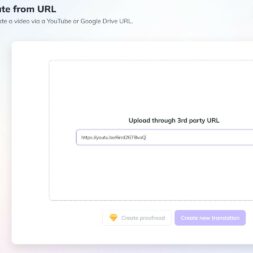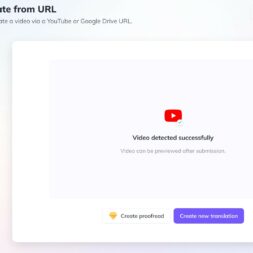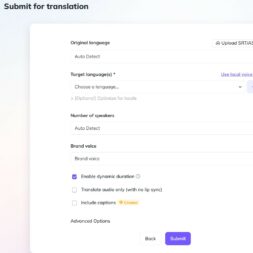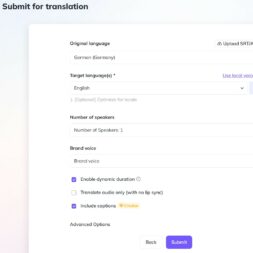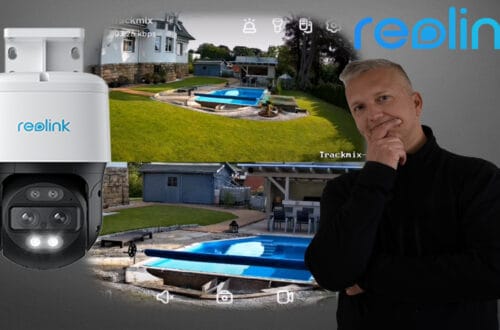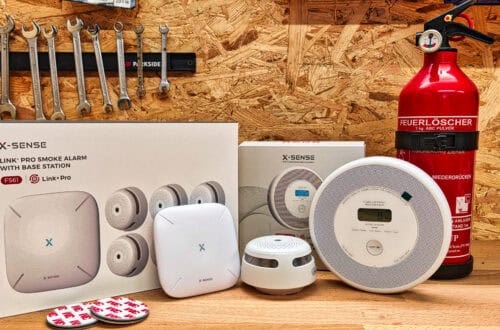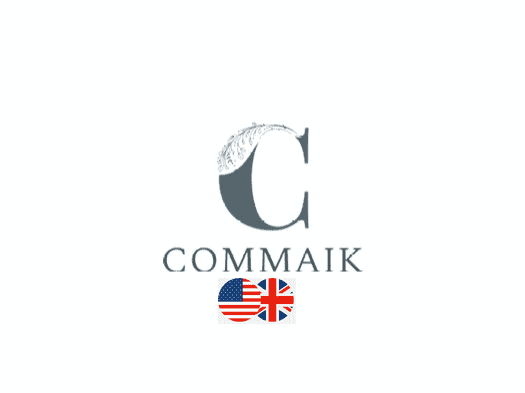
COMMAIK: HeyGen Video Translate – Translate videos on YouTube lip-sync with AI!
In order to increase the reach of my YouTube channel COMMAIK specifically for German and English-speaking viewers, I have set up separate channels: “COMMAIK” with videos for the DACH region and “CommaikEnglish” with content for the international audience in English.
In this article, I describe my approach to translation, the technical background to this decision and the use of the AI tool HeyGen for lip-synchronous translation and dynamic video length adjustment. HeyGen offers the possibility to translate videos into different languages, including English, Spanish and Hindi.
For a long time, the expansion of my YouTube channel “COMMAIK” was designed to reach an international audience and make the content accessible to a wide range of users.
After publishing almost 200 videos, I decided to translate the description and transcript of the subtitles of my videos into different languages.
For the description, I used the translation service Deepl, while YouTube’s automatic subtitle translation was used for the subtitles.
Although my commitment to multilingualism had a positive impact on my English-speaking reach, I found that it also had unexpected side effects on my German audience.
In the following, I will go into the details that ultimately led to the decision to set up a second channel, “CommaikEnglish”.
What you can expect in this article:
- Reach strategy for COMMAIK: How I clearly separated my target groups by splitting into two YouTube channels – “COMMAIK” and “CommaikEnglish”.
- Google ranking and visibility problems: Why the English translation of my content led to a drop in visibility in German search results.
- Technical background: How the Googlebot and language prioritization on YouTube influenced the ranking of my videos.
- Solution with HeyGen: The use of the AI tool for lip-synchronous translations and dynamic adaptations to prepare English content professionally.
- Experiences and tips: My workflow for creating and translating videos as well as practical tips for separating target groups.
- HeyGen’s pricing model: An overview of the pricing options for AI translation and my choice of the right plan.
Why Google categorized my YouTube videos as English-language
To increase the reach of my YouTube channel COMMAIK and reach an international audience, I added English titles, descriptions and subtitles to my videos. I assumed that this would appeal to a larger target group.
However, an unexpected problem arose: Google increasingly categorized my videos as English-language and placed them mainly in English-language search results. As a result, my content lost visibility in the German Google results and thus for the DACH region (Germany – Austria – Switzerland).
The reason is that Google is recognized as an “English-speaking user”. The Google indexing robot (Googlebot) usually accesses content from US IP addresses in the standard procedure.
In this case, YouTube offered him the English-language content of my videos. As a result, the English titles and descriptions were preferentially recognized and indexed by Googlebot.
YouTube’s language and localization settings also play a role here: If multilingual videos are available, the search engine uses the version preferred by YouTube – in this case English – and partially ignores the actual main video language.
Through this process, the algorithms interpreted the English metadata, titles and descriptions of my videos as the primary language and increasingly categorized the content for an English-speaking audience.
The English content became so dominant that Google displayed my videos almost exclusively in English search results, while the German-language visibility in the organic Google results fell sharply.
Interestingly, the internal YouTube search remained unaffected. My German-speaking subscribers were still able to find me directly on YouTube.
However, in organic Google search, which is often a decisive factor in attracting new viewers, my videos were increasingly being pushed aside.
This led to a significant drop in my hits from German-speaking countries, which originally amounted to around 90% and fell considerably as a result.
Why COMMAIK now runs two YouTube channels: The strategy behind it
After analyzing the data and feedback, I decided to remove the English translation of the title and description.
After some time, my videos gradually returned to the German-language Google search results and my click numbers from the DACH region increased again.
As around 90% of my viewers are from German-speaking countries and mainly come from Germany, Austria and Switzerland, it made sense to focus the COMMAIK YouTube channel on my German target group again.
However, I did not want to neglect the English-speaking audience, which comprised around 3% from the USA and 2% from England.
This led to the plan to split my content into two separate channels – “COMMAIK” for the German-speaking audience and “CommaikEnglish” for the English-speaking community.
Strategies and considerations for the second YouTube channel
Setting up a second channel offers many advantages, but also challenges, which I thought through carefully in advance:
- Target group focus: By distributing my content across two channels, I can tailor my approach to the specific needs of the respective target groups. “COMMAIK” will remain a German-language channel, while “CommaikEnglish” will be a clearly defined platform for my English-speaking audience.
- Channel positioning and brand preservation: When choosing the name for the new English-language channel “CommaikEnglish“, it was important to me to retain the recognition value of the “COMMAIK” brand. The addition of “English” clearly signals the target group without diluting the brand and provides orientation for English-speaking users. In this way, the brand remains consistent in both language areas, while both channels are clearly differentiated from one another.
- Target group-specific content for each channel: In the future, I will create my content specifically for the interests of the German and English audiences. For the time being, however, my focus was on preparing the existing videos for the English-speaking audience and uploading them to “CommaikEnglish”. I want to retain the English-speaking viewers I have gained and provide them with relevant content, while continuing to serve the DACH region with “COMMAIK”.
- Linking in the blog and using WPML: I have already implemented a similar strategy in my blog by having content translated for different target groups. There I link the YouTube videos specifically and offer an overview of the German-language content here. In order to reach my international audience, I have gradually translated my entire blog into English. I use the WordPress plugin WPML (WordPress Multilingual Plugin), which enables flexible and comprehensive management of multilingual content. WPML supports over 65 languages and allows you to easily translate and customize pages, posts, menus and widgets for each language version. By using this tool, I can offer my English visitors a separate overview of my videos, which can be accessed via this link. WPML automatically takes care of the SEO-relevant indexing of the language versions and enables a consistent brand presence in several language areas.
- SEO benefits of channel separation: As both channels are now focused on one language each, there is less risk of my videos being pushed out of the local search results again. The separation makes it possible to develop targeted SEO strategies for each channel so that the content is precisely optimized for the respective target group.
AI translation with HeyGen: Natural videos through lip-synchronization
I used the HeyGen tool for the English content, which is not only known for its AI-supported video transformations, but also offers a range of other innovative functions.
In addition to automated, lip-synchronized AI translation of videos, HeyGen enables the creation of fully AI-generated videos with realistic avatars. These virtual figures look so lifelike that they are virtually indistinguishable from real people.
They can be used seamlessly in different scenarios and offer an authentic presentation that is ideal for interacting with a global audience.
A particular highlight is HeyGen’s lip-synchronization technology, which makes it possible to adapt mouth movements precisely to the new target language. This creates a fluent and natural flow of speech that is intuitive and credible for the audience.
Video translation workflow with the HeyGen tool
In detail, my workflow for video translation and adaptation looked like this:
- Insert video URL: First, I inserted the URL of my German video into HeyGen, which allowed the tool to access the video data directly.
- Uploading the subtitle file: I then uploaded the German subtitles as an SRT file to ensure the exact language content.
- Select source and target language and number of speakers: I set the source language to German and the target language to English and selected the number of speakers in the video to ensure precise synchronization.
- Activate dynamization and lip-sync: For a natural result, I activated dynamization, which automatically adjusted the video length to the new language version. I also switched on the lip synchronization so that the mouth movements matched the English language.
- Generate subtitles: HeyGen automatically generated the new English subtitles. I edited these where necessary to ensure maximum comprehensibility.
- Export and post-production: After editing, I downloaded the finished video and prepared it for uploading to “CommaikEnglish”. I converted the subtitles provided by HeyGen in ASS format to the SRT format accepted by YouTube before uploading them to the new channel together with the video.
- Manual fine-tuning of the texts: I translated titles and descriptions into English using Deepl and made manual adjustments to make the content precise and appealing to an English-speaking audience.
This workflow allowed me to prepare my content efficiently and professionally for an international audience while maintaining the authenticity and quality of the videos.
Comparison: German and English version of the Reolink Home Hub video
For anyone interested in using the Reolink Home Hub as a centralized storage and camera monitoring solution, two versions of my video are now available – a German and an English version.
In the German version of the video, I go into detail about unboxing, installing and setting up the Reolink Home Hub on the client and in the app. This version is aimed specifically at viewers in the DACH region and explains how the hub solution can be optimally integrated into a smart home system.
I have also created an English version of the video for my international audience. This contains the same content, but adapted and presented in English. This means that English-speaking viewers can also get to know the Reolink Home Hub and benefit from the detailed explanations on installation and use.
Both videos provide comprehensive information about the Reolink Home Hub and give an insight into how this solution works – ideal for getting to know the advantages of this system in German and English.
For a direct comparison of the automatic lip-sync and translation by HeyGen, it is worth watching both versions of the video.
This makes it clear how precise and natural the English dubbing is compared to the German original and how well HeyGen has adapted the content for an international audience.
Watch German video
Watch the video:
Test HeyGen and use additional credits
If you create videos yourself and can imagine dubbing them in multiple languages with your own voice – then I can really recommend Heygen. I’ve been using it for my English channel for some time now and am delighted with the possibilities.
👉 Via my partner link you will receive 300 free credits when you take out a subscription:
🔗 https://www.heygen.com/invite/b96cdcf6
With your registration you support my channel at the same time – thanks for that! 🙌
HeyGen prices at a glance: The right model for every budget
HeyGen offers several pricing options that are flexible and scalable according to your needs. These price models cover various use cases – from a free trial version for beginners to a comprehensive enterprise solution for companies with special requirements.
HeyGen price plans and functions
Free Plan:
- Price: $0/month
- Functions:
- Creation of up to 3 videos per month with a length of up to 3 minutes.
- Video export up to 720p.
- Includes a video avatar and basic security functions.
Creator Plan:
- Price: $29/month (billed monthly); 22% discount for annual payment.
- Functions:
- Unlimited video creation with a maximum video length of 5 minutes.
- Video export in 1080p.
- Includes everything from the Free plan, plus watermark removal and faster video editing.
Team Plan:
- Price: $89/month per user (with 22% discount for annual payment).
- Functions:
- Unlimited video creation with a maximum video length of 30 minutes.
- Export in 1080p.
- Includes three video avatars, an interactive avatar and a brand kit for brand customization in addition to the Creator features. This plan also offers a multi-user workspace with role management and faster video editing.
Enterprise Plan:
- Price: Individual on request.
- Functions:
- Unlimited video creation without length restrictions.
- Export in 4K.
- Includes all the features of the Team Plan, with advanced features such as Translation Proofread, Brand Voice and Enterprise Security Standards. The plan also offers prioritized support, a dedicated account manager and studio quality for professional requirements.
Conclusion and choice of team plan
As I have already created almost 200 videos, most of which are significantly longer than 5 minutes, the Team Plan was the ideal choice.
With video lengths of up to 30 minutes, this plan perfectly covers the requirements of my channel, as only a few videos exceed this length.
The Enterprise plan with 4K export and other professional features that was offered to me for $10,000 per month was well outside my budget and would have been overkill for my purposes.
In the following table of HeyGen plans, I have clearly presented the most important functions and price options:
| Plan | Price (monthly) | Max. Video length | Video quality | Number of videos | Avatars & interactive functions | Additional functions |
| Free Plan | $0 | 3 minutes | 720p | Up to 3 videos/month | 1 video avatar | Basic safety functions |
| Creator Plan | $29 (22 % discount with annual subscription) | 5 minutes | 1080p | Unlimited | Everything in the Free Plan, plus: | Removal of the watermark, faster rendering |
| Team Plan | $89/user (22% discount for annual subscription) | 30 minutes | 1080p | Unlimited | 3 video avatars, 1 interactive avatar | Multi-user workspace, brand kit, role management, faster rendering |
| Enterprise Plan | On request (approx. $10,000/month) | No limit | 4K | Unlimited | 3+ interactive avatars | Translation proofread, brand voice, enterprise security functions, dedicated account manager, highest rendering speed |
This table shows the price levels and the functions included in each HeyGen plan.
The Free Plan offers a basic version with limited functions, ideal for trying out.
The Creator Plan is suitable for individual users with short video content, while the Team Plan is ideal for teams and more frequent video creation thanks to its extended functions and longer video lengths.
Finally, the Enterprise plan covers all professional requirements, but is mainly suitable for large companies with a higher budget.
Summary and conclusion
To make my YouTube channel COMMAIK accessible to an international audience, I started translating the titles and descriptions of my videos into English and adding subtitles using YouTube’s automatic translation function.
These measures expanded my reach, but led to an unexpected problem: Google increasingly categorized my videos as English-language, which made them less visible in German search results and significantly limited access from German-speaking countries.
To counteract this effect, I decided to open a separate channel called CommaikEnglish, which specifically provides English-language content.
With the help of the AI tool HeyGen, I was able to lip-sync and authentically translate the videos into English, dub them and upload them to the new channel.
HeyGen offers automatic video length adjustment and precise lip-sync functions that improve the viewing experience for English-speaking viewers.
With this separation, the COMMAIK brand remains present in both target groups, with COMMAIK focusing on the German-speaking community and CommaikEnglish on the English-speaking community.
FAQ for translating my YouTube videos with HeyGen
1. why was a separate English-language channel set up for COMMAIK?
The separation into two channels, “COMMAIK” for German-language content and “CommaikEnglish” for English-language videos, serves to specifically address the respective language regions. By splitting the videos, they remain visible to the target groups in the specific search results and ensure a higher reach.
2 What challenges did the translation of the video content entail?
The translation of the titles, descriptions and subtitles led to Google classifying the videos as primarily English-language and preferentially placing them in English search results. This significantly reduced the visibility and reach of the content in German-speaking countries.
3. how is HeyGen used for video production?
HeyGen enables lip-synchronous translation of videos. The tool not only adapts the mouth movements to the target language, but also dynamizes the video length. These functions make the English dubbing look natural and appealing.
4. what are the advantages of channel separation for the SEO strategy?
The channel separation allows targeted search engine optimization (SEO) for both target groups. This keeps visibility high for German-speaking viewers, while the English-language content also receives optimal placement in the English-language search results thanks to the separate channel.
5. what other tools are used to manage bilingual content?
In addition to HeyGen, the WPML plugin is used for the blog to efficiently translate the content into English and index it in search engines in an SEO-relevant manner. WPML also supports the organization of content, which enables consistent presentation in both languages.
6 Why was Deepl used for the translations?
Deepl was chosen because it offers precise and contextually accurate translations, especially for technical content. Titles and descriptions for the English-language channel are designed professionally and comprehensibly.
7 Who is the Team Plan at HeyGen suitable for?
The Team Plan is ideal for channels that create longer videos (up to 30 minutes) and frequently upload new content. It offers multi-user functions, multiple avatars and higher video quality, making it the ideal solution for teams and more intensive use.
8. what advantages does the separation into two channels offer for addressing the target group?
The specific division enables content to be tailored precisely to the interests and needs of German and English-speaking viewers. Viewers find targeted content in their own language and the brand message remains consistent in both regions.
9 What are the advantages of HeyGen’s lip synchronization technology?
Lip synchronization ensures that the mouth movements are precisely adapted to the English language. This gives the videos a natural effect and significantly improves the viewer experience, which is well received by international target groups.
10. how does the use of HeyGen improve international reach on YouTube?
Thanks to the lip-synchronous translation and dynamic video length adjustment with HeyGen, the content appears authentic and professional to the international audience. This quality leads to higher interaction and longer viewer engagement, which in turn increases organic reach and visibility in English-language YouTube search results.
Dieser Beitrag ist auch verfügbar auf:
English
Deutsch



